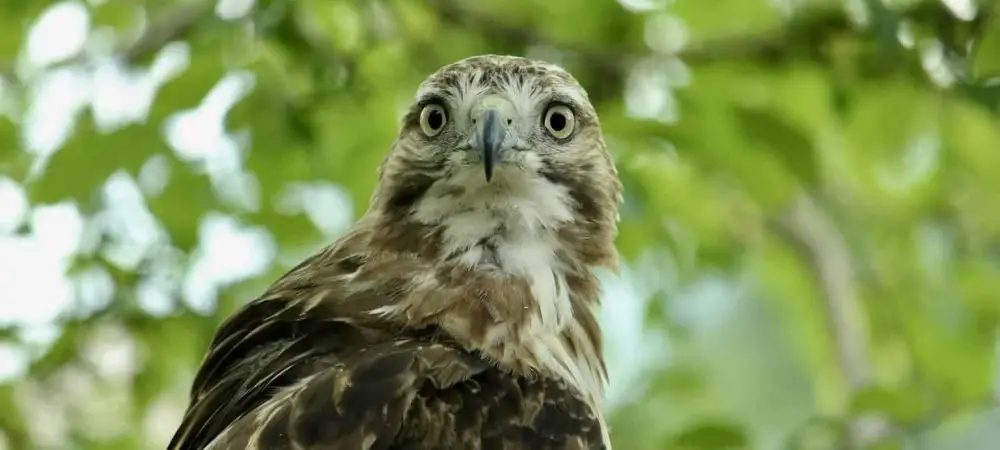
A total of 13 species of Hawks reside in Colorado. These are:
Table of Contents
Toggle- Red-Tailed Hawk
- Swainson’s Hawk
- Northern Harrier
- Cooper’s Hawk
- Sharp-Shinned Hawk
- Ferruginous Hawk
- Rough-Legged Hawk
- Northern Goshawk
- Broad-Winged Hawk
- Harris’s Hawk
- Common Black Hawk
- Red-Shouldered Hawk
- Zone-Tailed Hawk
Want to learn more? This book on the Birds of Prey of North America is a fantastic read!
Colorado is one of the Four Corners’ states and has a wide array of wildlife, particularly in its mountainous regions.
Although the state is best known for much of the wildlife other than birds, Colorado is home to many different types of birds, including thirteen species of hawks.
Since Colorado is such a large state with several distinct types of ecosystems, many different kinds of hawks are able to live there.
From the Rocky Mountains in the western part of the state to the grasslands in the east and the desert-like areas in the south, there’s a variety of habitats available to wildlife.
Between the high altitude and dryness of the state, as well as the extreme fluctuation in temperatures, Colorado’s climate is not always the most forgiving.
Despite this, wildlife, and hawks in particular, thrive in these conditions. Luckily, much of Colorado remains undeveloped land, providing the seclusion from humans that most animals seek.
With 42 state parks and 13 national parks, there are endless opportunities to get out in nature and do some bird-watching.
Which park you’ll want to go to depends on what type of hawk you’re looking for though, as the variety of landscapes and habitats varies so much between parks.
Want to attract birds of prey to your yard? Take a look at our article!
What Hawks can be seen in Colorado?
Table of Contents
1. Sharp-Shinned Hawk
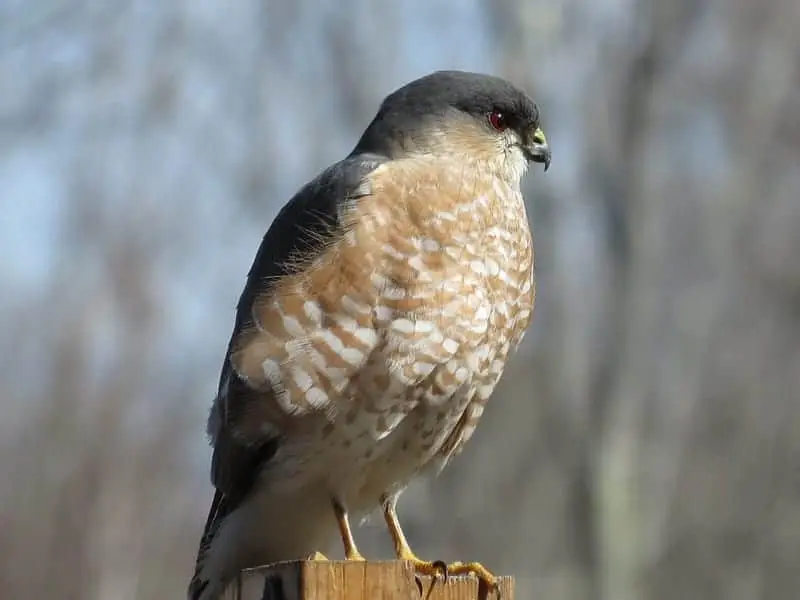
“Sharp-Shinned Hawk” by ‘Dennis Murhpy‘ is licensed under CC BY 2.0
Wingspan
43-56cm
Weight
87-218g
Life Expectancy
3 years
Diet
Robins and Thrushes
The Sharp-Shinned Hawk can be difficult to identify because it looks similar to the Cooper’s Hawk.
Both species have blue-gray feathers on their backs and light red-brown feathers on their underbellies.
One telling difference is that the Sharp-Shinned Hawk is much smaller in size and has longer legs that can be seen while the bird is in flight.
They are actually one of the smallest hawks in the US. Since the Sharp-Shinned Hawk has long legs and talons, they are able to easily catch moving prey and often hunt smaller birds.
Similar to the Cooper’s Hawk, this species will chase these smaller birds through forests, but also sometimes hunt at suburban bird feeders.
This hawk is better at sneaking up on prey than chasing it or diving for it. However, they cannot digest feathers, so they must pluck their prey before eating it.
When mating, the birds will often fly in circles around one another.
The Sharp-Shinned Hawk usually nests high up in pine or aspen trees, in forests with dense tree cover.
Both the male and female will bring prey to their young, but the male is only capable of catching small prey because of his smaller size.
This species of hawk can be found year-round in Colorado, but the most common sightings are between September and April, when they have migrated to the region.
They are widely distributed and can live in a variety of habitats, but the best places to see them are in dense forests, on the forest edges, or in suburban areas near bird feeders.
2. Cooper’s Hawk
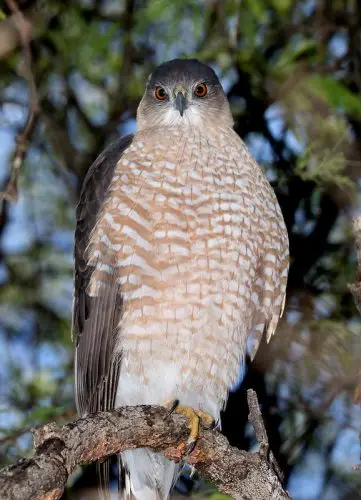
Wingspan
62-90cm
Weight
330-680g
Life Expectancy
Up to 12 years
Diet
Small Birds, Mice & Squirrels
The Cooper’s Hawk can sometimes be hard to identify because it looks very similar to the Sharp-Shinned Hawk.
Both the males and females have blue-gray feathers on their backs and light red-brown feathers on their underbellies.
The Cooper’s Hawk is medium-seized itself but mostly hunts other small birds.
They have been seen chasing these smaller birds through forests, but also hanging around suburban bird feeders in hopes of catching their prey off guard.
They can be violent hunters, catching prey and either squeezing or drowning it to death. Similar to most hawk species, the females are larger than the male, but the Cooper’s Hawk male is particularly obedient to the females.
The female signals when she is ready to mate and only after this can the male safely approach. Otherwise, he may end up as the female’s next meal.
After mating, the male builds the nest high up in a tree and provides almost all of the food for the chicks.
Although Cooper’s Hawks can be spotted year-round in Colorado, the best times to see them are in either April or October because this is when they tend to be the most active, mating or preparing for winter, respectively.
They live in wooded areas, so the mountains are a great place to spot this hawk in Colorado.
However, they also frequent suburban areas, so that can be a good place to watch for them too.
3. Northern Goshawk
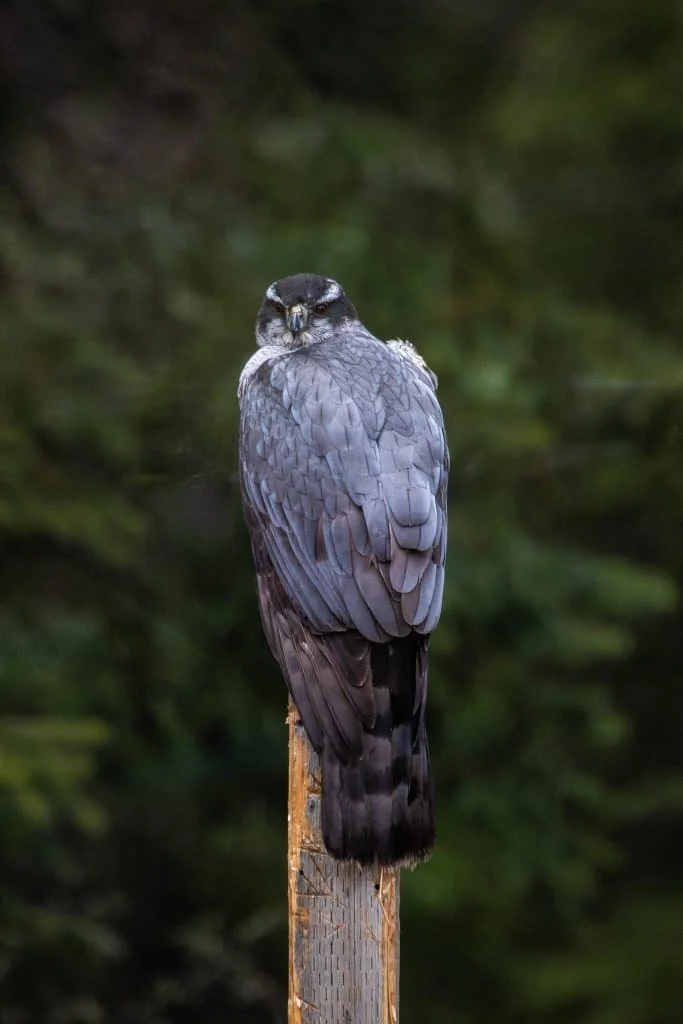
Wingspan
89-127cm
Weight
631-1364g
Life Expectancy
7 Years
Diet
Mammals, reptiles & insects
The Northern Goshawk has a unique color pattern with dark gray wings, a pale underbelly and black head with white streaks.
They also have red eyes, which are hard to spot from a distance, but very distinct up close.
They behave and hunt similarly to the Cooper’s Hawk or Sharp-Shinned Hawk.
The Northern Goshawk chases prey through forests and will hunt both other birds and mammals, fiercely hooking its talons into prey.
They are capable of carrying some rather large prey despite their size.
They are remarkably well-suited to high-speed pursuit of prey through dense forests and have been known to chase prey relentlessly, crashing through bushes or diving into the water if necessary.
The Northern Goshawk follows some unusual mating practices, often building and protecting multiple nests in a single mating season, despite only using one at a time.
Both the male and female can be incredibly aggressive when protecting a nest, and have been known to attack both animals and people that get too close.
They typically build their nests high up in trees and seek out forests with a strong canopy covering.
This species of hawk is relatively rare, but the best times to spot one in Colorado are in the summer between June and September. They tend to stay in dense forests, so they may be hard to f
4. Red-Shouldered Hawk
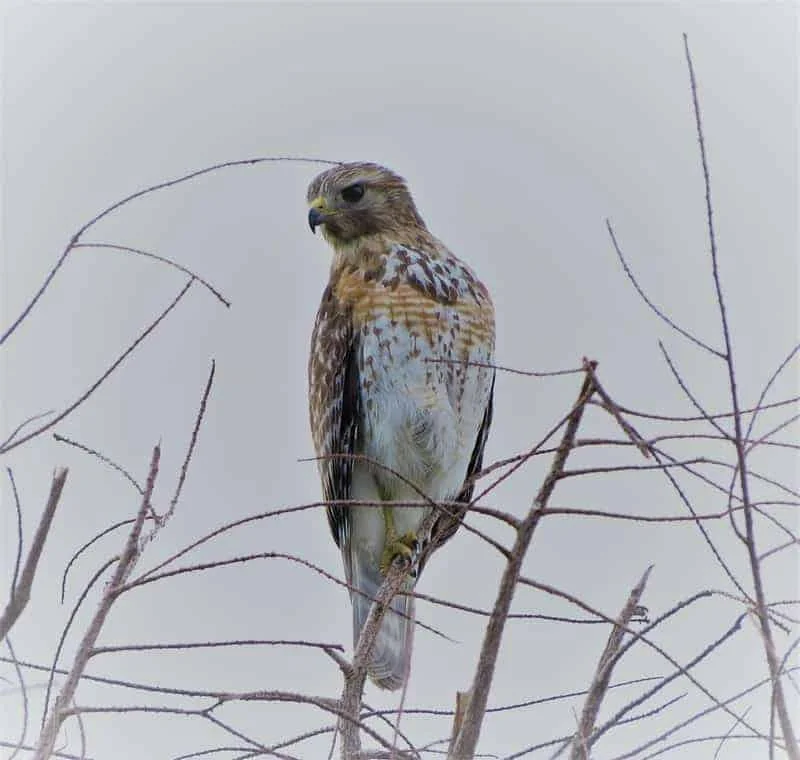
Wingspan
94-111cm
Weight
486g-774g
Life Expectancy
2 years
Diet
Small mammals, reptiles & amphibians
The Red-Shouldered Hawk has deep orange-red feathers on their bodies and the top of the wings, with a black and white checkerboard pattern covering their underwings.
Their tail is relatively long and has a black and white striped pattern.
This hawk can most often be found in forests near bodies of water, but have also been known to live in residential areas because of the easy prey it offers.
They can also be seen soaring and circling when mating, with the male usually putting on an extensive show in the air.
When nesting, the Red-Shouldered Hawk almost always reuses nests from previous years and will return to the same area, if not the exact same nest, for many years on end.
They can be aggressive and have been known to attack other birds, including owls, and even people, when they feel threatened.
Although a rare sighting in Colorado year round, the best chances of seeing the Red-Shouldered Hawk are in tall trees near bodies of water, where they often perch while hunting.
Colorado doesn’t offer the ideal habitat for this species, so there’s only a small population in the state.
5. Broad-Winged Hawk
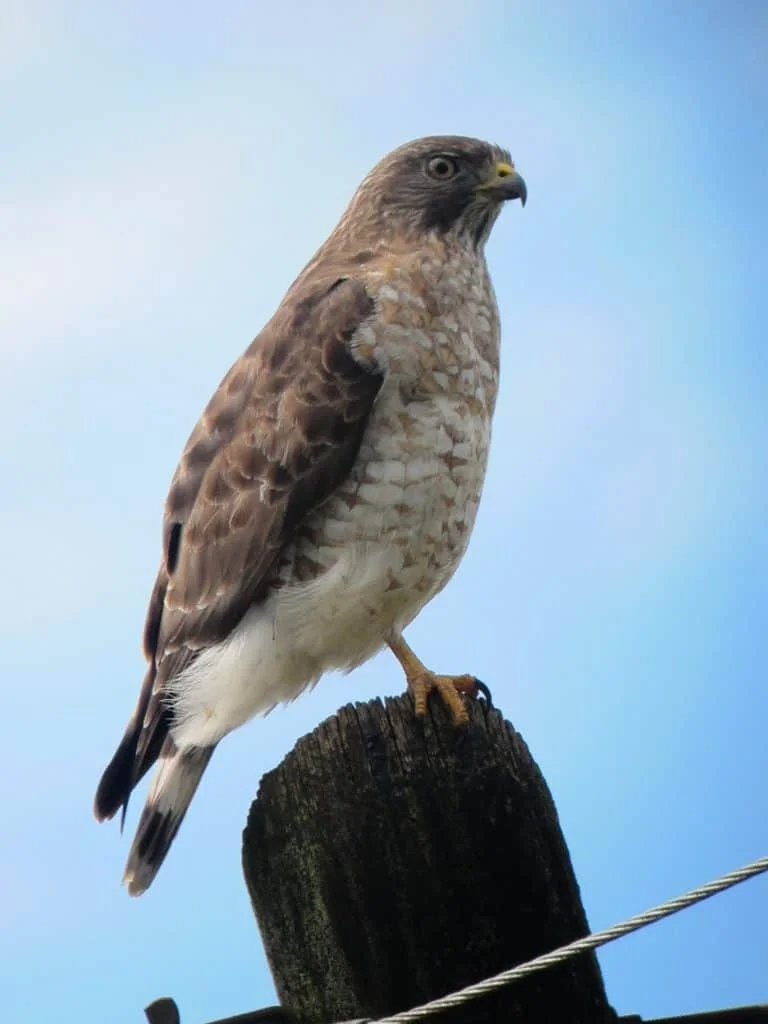
“Broad Winged Hawk” by ‘Felipe Uribe‘ is licensed under CC BY 2.0
Wingspan
81-100cm
Weight
265g-560g
Life Expectancy
Up to 20 years
Diet
Small mammals & insects
The Broad-Winged Hawk is easily identifiable by its solid red-brown back, light red underside, and black and white banded tail feathers.
This species will perch in trees when watching for prey, and then dive for it, eating a wide variety of small animals.
When nesting, the Broad-Winged Hawk will sometimes build a new nest as a pair, but will also reuse nests from previous years or steal the nests of other birds.
They often nest in the lower part of the forest canopy. Some individuals are monogamous but many others will find a new mate each year.
Their mating call is very distinct and sounds like a shrill whistle. These hawks are most well-known for their tendency to migrate in large flocks, called ‘kettles.’
Despite their long journeys, they can almost always be found in the forest, lingering near the edge of the treeline and near bodies of water.
Although this species has been spotted in Colorado, they are only present in the state for very short windows of time due to their migration patterns.
These hawks spend winters in the northern US and Canada, but migrate all the way to South America in the summers, meaning that they only pass through Colorado on their journey.
The best times to spot them are the beginning of May and the end of September. A small number of hawks tend to stay in Colorado the entire summer, but it’s a very low number.
6. Swainson’s Hawk
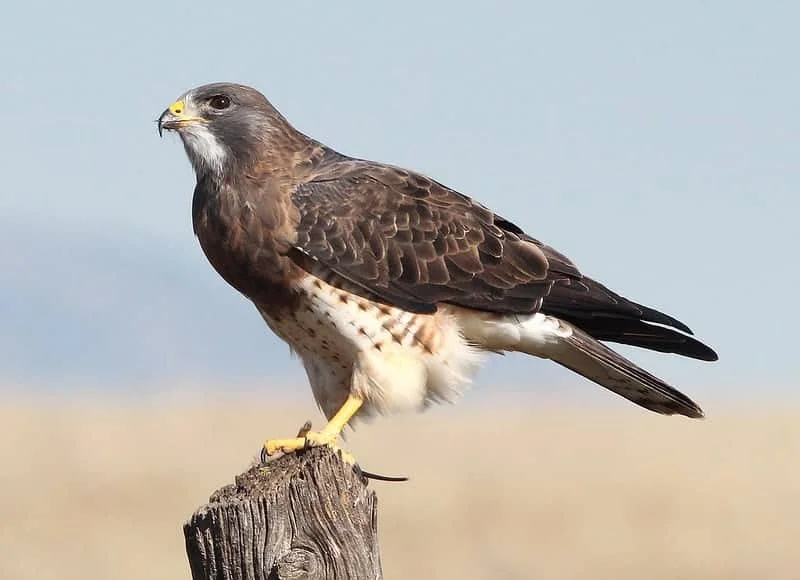
Wingspan
4 feet
Weight
693-1367g
Life Expectancy
16-19 years
Diet
Mammals & Insects
Although the Swainson’s Hawk is short in length and has a small tail, they are known for having a very large wingspan.
Their color patterns vary quite a bit, ranging from light brown and gray to dark red or even black. Almost all Swainson’s Hawks have white underwings with streaks of darker feathers.
Most of the Swainson’s hawks in Colorado are light colored. These birds tend to stay in groups, living and hunting in flocks, or “kettles”, nearly year round.
They nest in trees and often steal the old nests of other birds, rather than building new ones for themselves.
The best place to see a Swainson’s hawk in Colorado is on the eastern plains, but occasionally they can be found further west in more mountainous regions.
They will often be seen either soaring across open prairie or perched in a high place to look for food.
Most Swainson’s Hawks migrate to South America for the winter, so the best time to spot them in Colorado is between the months of May and September between their migratory periods
7. Red-Tailed Hawk
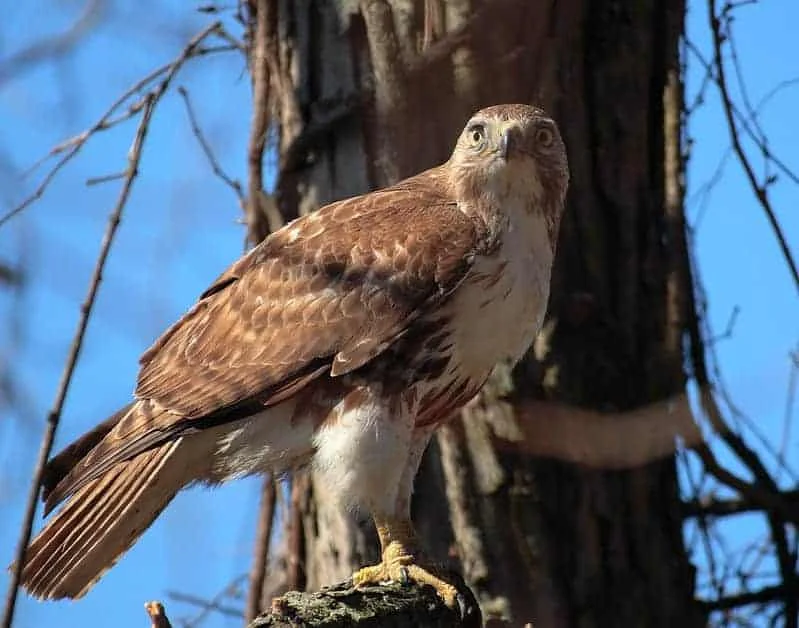
Wingspan
114-133cm
Weight
900-1460g
Life Expectancy
10-15 years
Diet
Small mammals, mice & voles
One of the most common hawks across all of North America, Red-Tailed Hawks are the most common type of hawk found in Colorado.
They are usually easy to spot because they are rather large and have very distinctive red tail feathers.
Their white underbelly is also a defining characteristic, but some individuals have darker feathers as well.
These hawks are also known for their elaborate mating rituals, which often involve the male doing a series of fast and steep dives in the air before latching talons with the female and continuing to do acrobatics together.
Once mated, these birds stay together for life and may even hunt together as a pair.
Red-tailed Hawks tend to nest near the tops of trees or high up on manmade structures, so they can get a good view of the surrounding land.
They are known to be very aggressive when defending their nest and will regularly fight off larger birds if needed.
The best places to spot these birds are in open spaces. They aren’t picky about the type of habitat though, and can live in everything from plains to forests to deserts, as long as there’s open air space.
Oftentimes, they can be found either soaring across these open spaces or perched at the tops of trees or telephone poles, searching the landscape for something to eat.
They can be seen with high frequency in Colorado year round, but the most common sightings are in the winter months.
8. Rough-Legged Hawk
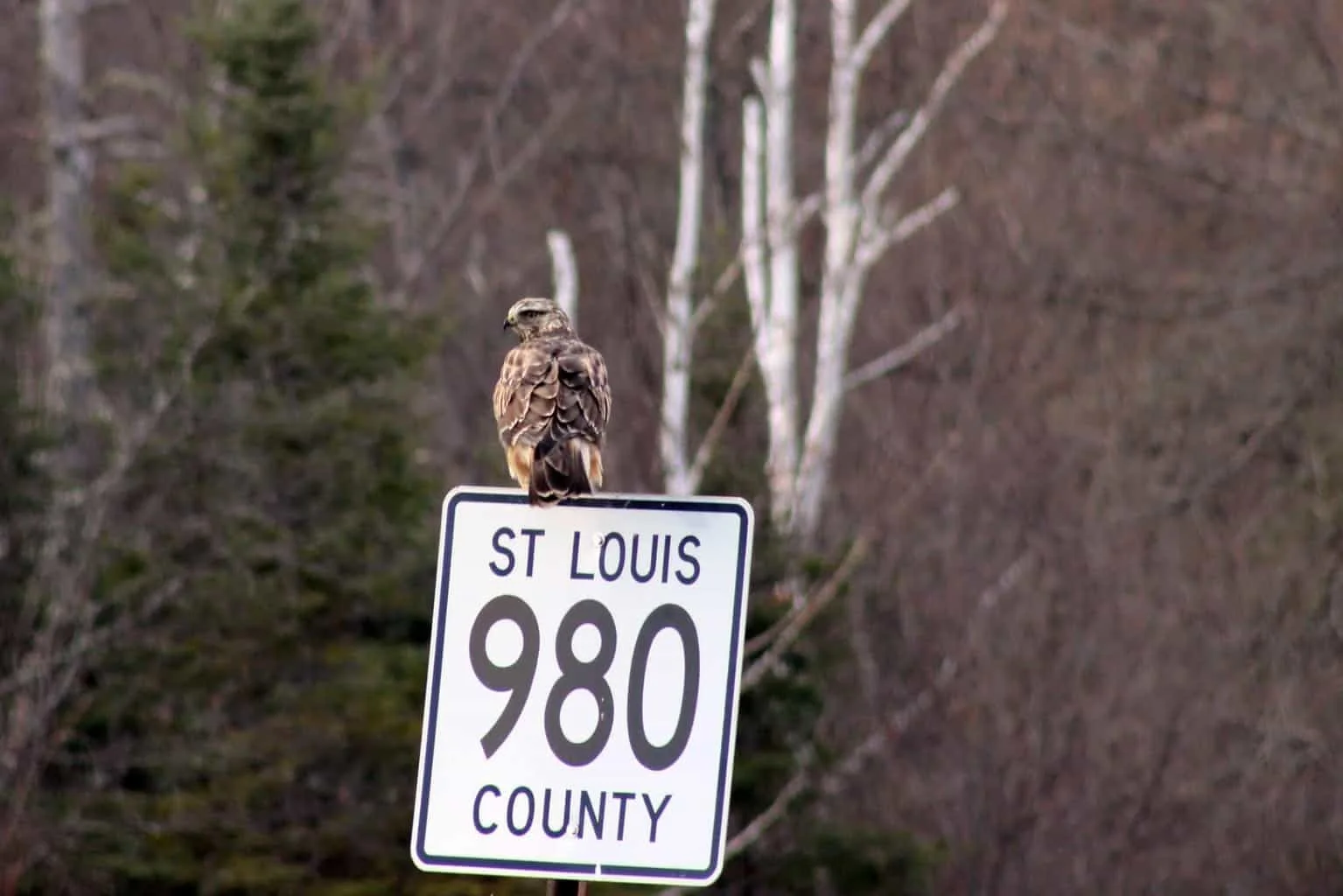
Wingspan
132-138cm
Weight
715-1400g
Life Expectancy
Up to 18 years
Diet
Small rodents
Rough-Legged Hawks are known for their long, narrow wings and their feathered legs.
Their colors are also somewhat distinct, with either pale or dark bodies, a dark belly, and bright white bands on their underwings and tails.
These birds can be very large and they consume much more food than other hawk species.
They will consume approximately 10% of their body mass in food every single day and so they spend most of their time hunting. They typically hunt in marshes or other open areas.
The Rough-Legged Hawk typically nests on cliffsides. However, they don’t nest in Colorado because they are only temporary migratory residents and they mate elsewhere.
They do seem to be monogamous and are even known to live in groups at certain points throughout the year.
This species spends most of its time in Canadian or Arctic tundras, but migrates south for the winter, which is when they are most commonly seen in Colorado.
It’s incredibly rare to see a Rough-Legged Hawk in Colorado outside of the winter months. The best places to see them are
9. Ferruginous hawk
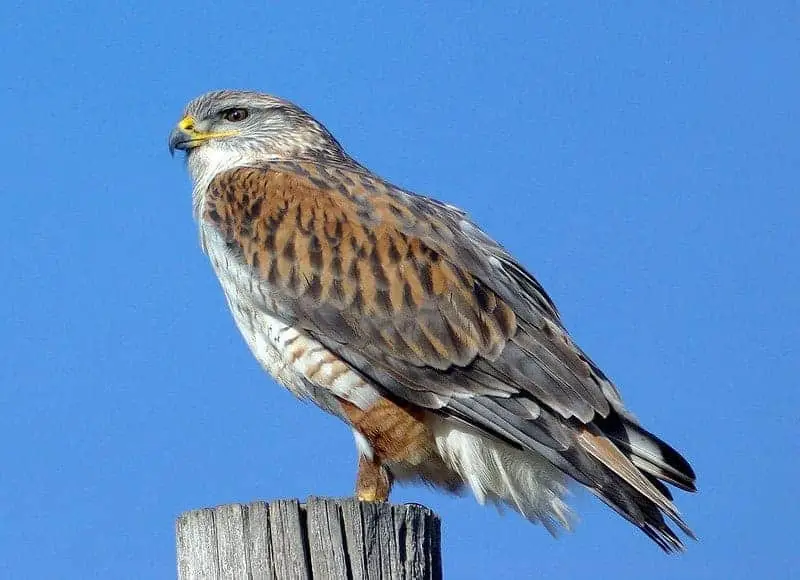
Wingspan
133-142cm
Weight
977-2074g
Life Expectancy
16-20 years
Diet
Small mammals
Ferruginous Hawks have a distinct color pattern with a grayish head, red or deep brown wings, and a bright wide underbelly and underwing.
They are a relatively large species and tend to group together when they hunt.
However, they do not work in groups at all during the mating season. The nesting habits of this species are also rather unique.
They rarely build their own nests, instead choosing to reuse the old nests of other birds.
When they do build their own nest though, it can be anywhere from high up in a tree to on a cliffside to on the ground, and it’s usually made of thick, sturdy sticks rather than twigs or leaves.
The Ferruginous Hawk tends to be monogamous but not all individuals follow this practice.
The Ferruginous Hawk is most often spotted in Colorado in the winter months between November and February, but it’s not uncommon to see them at other times of the year as well.
This is due to their migration patterns. They prefer wide open spaces, so the plains are the best place to spot a Ferruginous Hawk, either circling overhead or perched in one of the few trees available.
10. Northern Harrier
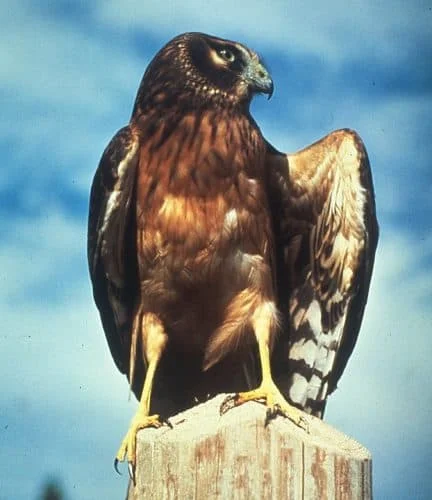
Wingspan
120cm
Weight
390g
Life Expectancy
16 years
Diet
Rodents and small birds
The Northern Harrier is one of the larger hawks found in Colorado and can be recognized by its long tail and flat, owl-like face.
The owl-like features mean that this bird hunts using similar strategies to an owl, relying on both hearing and vision to catch prey.
They have bright yellow eyes, although eye color may be different among young hawks. Males are gray and white, while females are brown.
Females also tend to be larger than the males. Males perform elaborate flight routines and dives to attract a mate.
Most males will mate with several different females over the course of a single mating season, but the male will generally help raise all nests he is responsible for.
Nests are built on the ground, in places sheltered by vegetation such as grass or bushes.
The hawks can be vicious when defending their nests from ground predators and they also tend to nest in clumps so that multiple hawks are always nearby to help protect the eggs and chicks.
The Northern Harrier generally hunts small prey, but they are powerful birds and have been known to occasionally take larger prey, sometimes drowning the animals first.
This hawk can be seen year-round in Colorado but is most commonly spotted in the winter months.
They generally stay in either the deserts or grasslands of Colorado and would be a rare sight anywhere in the Rocky Mountains.
The best chance of spotting a Northern Harrier is when they’re in flight because of the distinctive v-shape they make with their wings when soaring.
11. Zone-Tailed Hawk
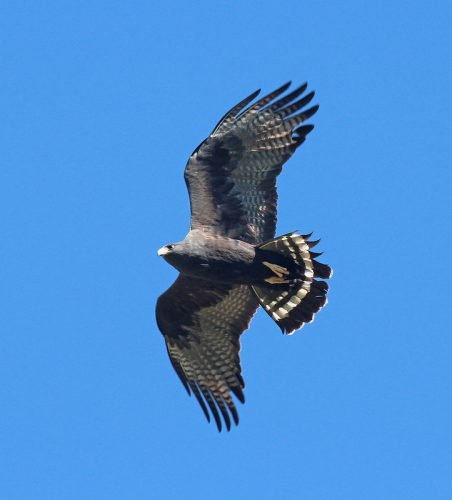
Wingspan
120cm
Weight
600-900g
Life Expectancy
4 years
Diet
Other birds, sometimes lizards
The Zone-Tailed Hawk can be recognized by its black body, gray-silver wings, and black and white banded tail.
They look and behave similarly to turkey vultures, but the tail feathers help distinguish between the species.
This hawk is known to hunt a wide variety of different prey using a variety of different tactics.
They will dive from the air, fly low to the ground until they come across prey, dive for fish in ponds or streams, and even pursue prey through the air.
When Zone-Tailed hawks mate, they will put on elaborate flight displays with each other and may continue this activity even after mating.
Pairs then build a nest together and viciously protect it, having been known to attack other birds and even people when they are too close to the nest.
This species of hawk mostly resides in the southern US, but their population and territory has been slowly expanding northward, so it’s possible to see them in Colorado.
Although a pretty rare sighting in Colorado, they are occasionally seen in the foothills or the mountains and the best time to see one is during the summer, when they are more likely to have migrated north.
12. Harris's Hawk
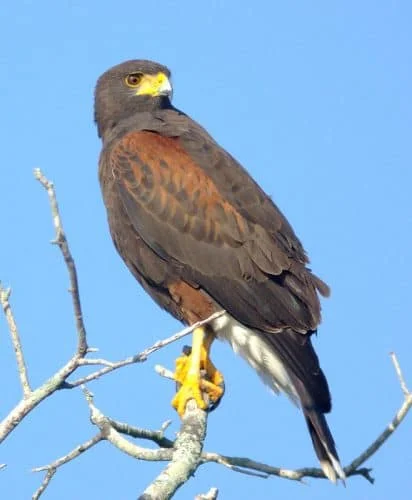
Wingspan
110cm
Weight
700g
Life Expectancy
15 years
Diet
Small mammals, birds & rodents
The Harris’s Hawk has a very unique appearance. They are mostly brown but have reddish shoulders and black and white tail feathers.
Sometimes they also have white streakings on their wings. These hawks mostly hunt small mammals and rodents.
They are also known to be social hunters, teaming up with several other hawks and sharing food between the group members.
They can be defensive of prey and will attack an intruder as a group if they feel threatened. This social behavior is very unique among hawks.
Not only do Harris’s Hawks hunt together, but they also defend a collective territory together, breed within their groups, and live within a social hierarchy.
The Harris’s Hawk will nest almost anywhere, choosing locations such as trees, cactuses, cliffsides, and telephone poles.
Breeding pairs often have support from their group with building nests and providing food for the young.
Although the Harris’s Hawk is pretty rare in Colorado, the best chances of seeing one are in the winter months between December and February.
They mostly live in the Southwest US, but some live a little further north in Colorado.
Their preferred habitat is deserts or prairie, so southern or eastern Colorado are the best viewing locations.
13. Common Black Hawk
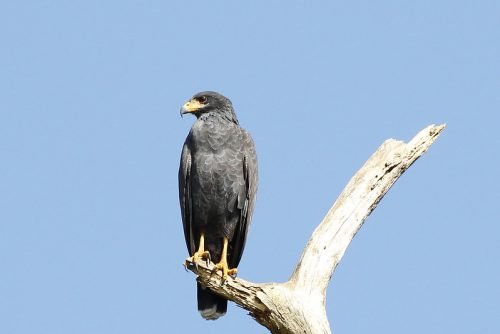
Wingspan
127cm
Weight
950g
Life Expectancy
13 Life Expectancy
Diet
Snakes, frogs and Fish
True to its name, the Common Black Hawk is an entirely black bird with only a single white band on its tail.
Younger hawks are a dark brown color but have the same white tail band. These birds hunt mostly in the water, perching above bodies of water and then diving for fish, crabs, or water snakes.
They will occasionally also hunt for small mammals or steal eggs from various different types of nests.
When mating, the Common Black Hawk is generally monogamous and will return to the same nesting territory for several years in a row.
They sometimes construct their own nests, but often will reuse old ones from other birds.
This hawk is a pretty rare sighting in Colorado, but it is generally spotted in the summer months and the best chances of spotting one are in forested areas near bodies of water.
The Common Black Hawk mostly resides in the Southwestern US or further into South America, but occasionally can be found in Colorado.

More Articles.
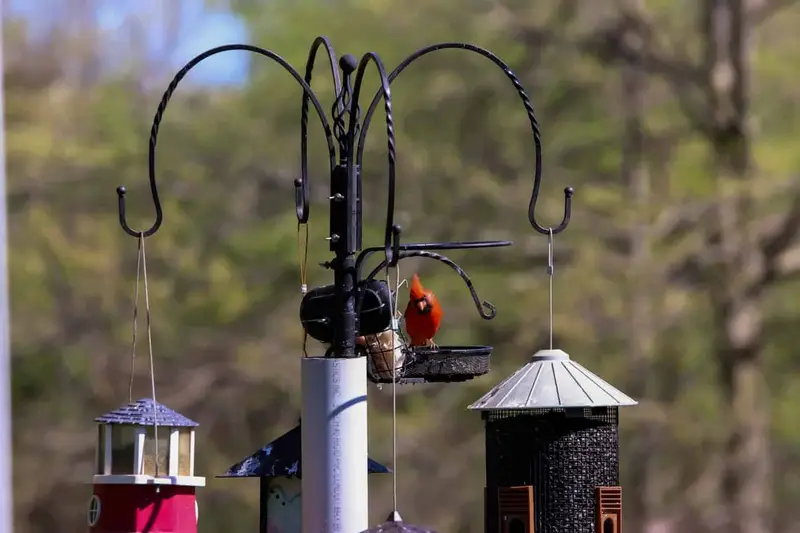
When you are looking to buy bird feeders, you will inevitably be met with recommendations
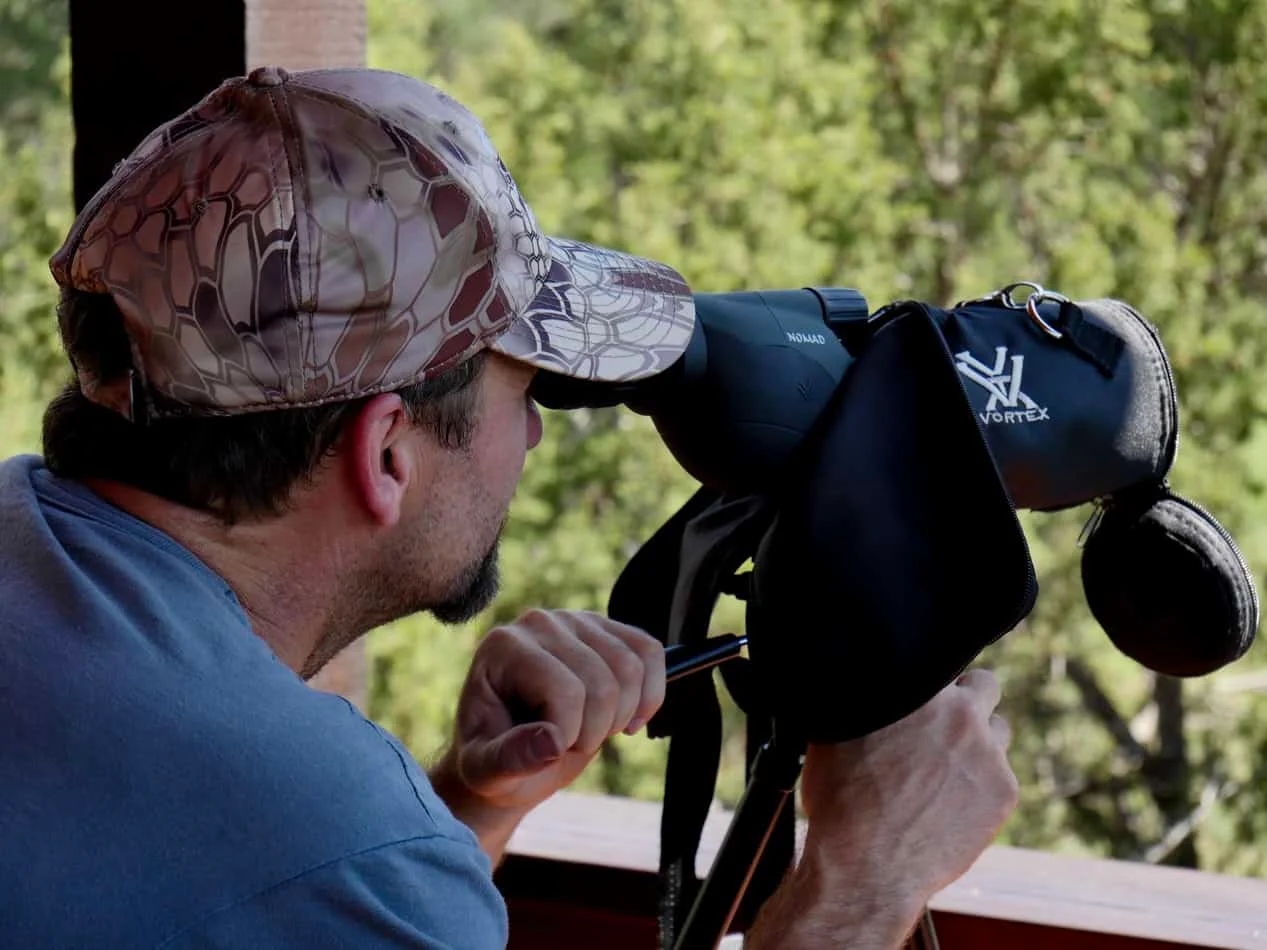
Best Spotting Scopes for Birding 2020
When it comes to birdwatching, you want to make sure that you have the right
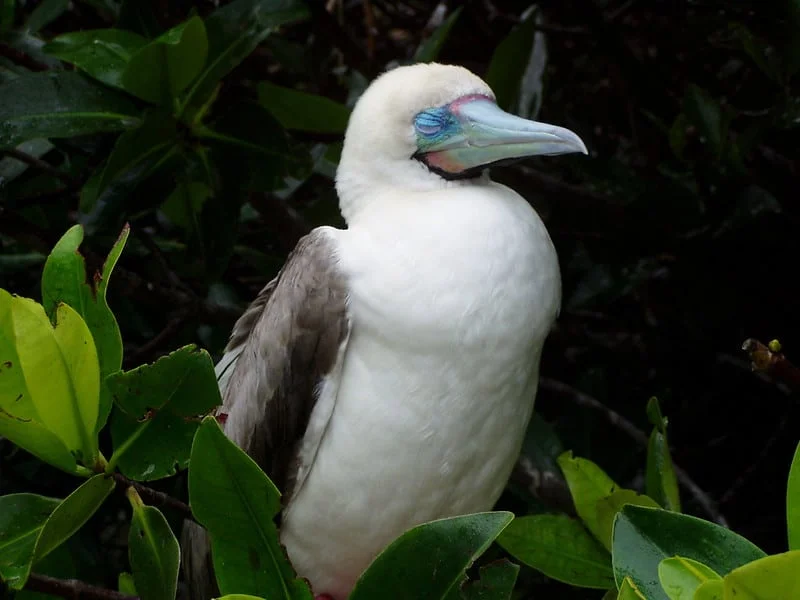
North American Birds with a White Breast (18 Species with Pictures and Sounds)
Canada and America are filled with many wonderful birds with a white breast – in

About Us
We are avid bird-watchers who recently retired, allowing us more time to travel the world. Fortunately, we have managed to visit numerous countries around Europe, Asia, and America. Watching and photographing birds has been a passion for many years and we are making the most of the extra time on our hands!

